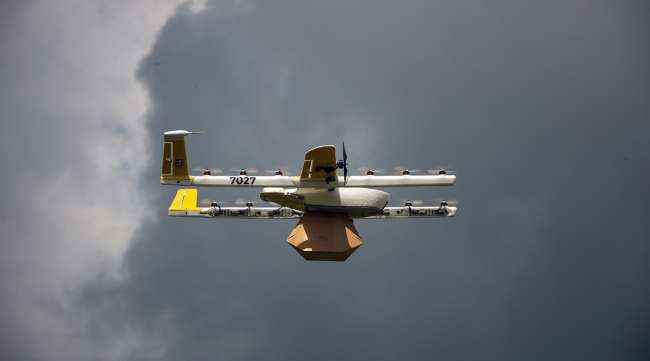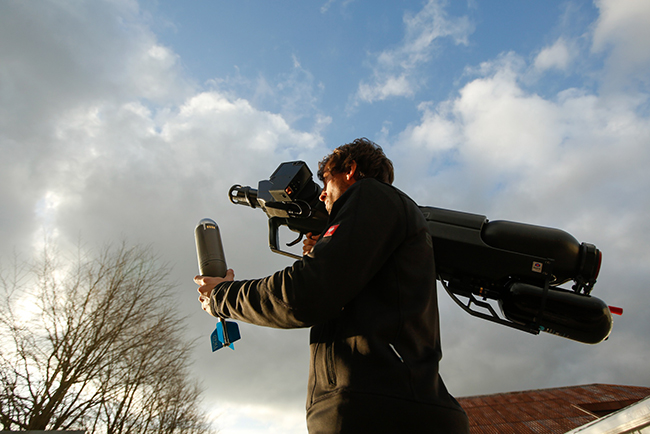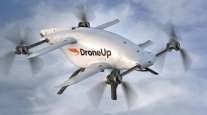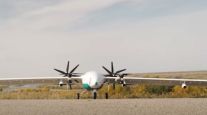Catch Them if You Can: The Soaring Business of Downing Drones

Just shoot them down?
After troublesome drones infiltrated London’s Gatwick airport late last year, disrupting passenger flights and costing potentially millions of pounds in revenue, that was the instinctive question posed by the watching world.
But for some businesses, shooting them down is a dangerous and unfeasible answer. They’re starting to tout better ideas: firing a net, jamming the drone, using a bigger drone to scoop it up.
These companies are part of an emerging industry offering myriad solutions, all hoping to solve the problems caused when drones fly where they are not supposed to. The U.S. Federal Aviation Administration announced in early 2018 it had logged more than 1 million registered drones, and Goldman Sachs Group Inc. predicts that by 2020, there will be 7.8 million shipments of consumer drones — an industry worth $3.3 billion in revenue. But as drones proliferate, major incidents likely will increase, raising questions about how to keep wayward devices in check.
“Laws will not stop drones; only technology will,” said Joerg Lamprecht, CEO and co-founder of Dedrone Holdings Inc., a company that specializes in drone detection. “The race is on, the future is unmanned, and we’ve got to be staying in charge and in control.”
Drones are becoming cheaper, increasingly accessible and more frequently used in business. An offshoot of Alphabet Inc.’s Google, Wing Aviation, on April 23 became the first drone operator to receive government approval as an airline, enabling it to begin routine deliveries in U.S. skies.
Amazon.com has experimented with delivery by drone, and construction companies such as McCarthy Building Cos. are using them to survey sites. Drone photography is proliferating and has sparked drone film festivals, and a breed of the devices designed for racing is rapidly gaining popularity. Let’s not forget finance types, who can invest in an exchange-traded fund dedicated to drone-focused stocks.
But when drones become problematic, and require detecting and disabling, it’s too dangerous to just shoot them down, even if that seems like the easiest answer, according to Arthur Holland Michel, co-director at the Center for the Study of the Drone at Bard College in New York. Bullets aimed at drones need to land somewhere, potentially causing damage and harm.
In addition, drones aren’t that easy to hit. Take the example of the DJI Phantom 4, the most popular drone in the United States, according to FAA data, analyzed by Bard. This drone — succeeded now by newer models — has a top speed of about 45 mph, can fly as high as 3.7 miles, and boasts an almost 30-minute flight time, according to its manufacturer, SZ DJI Technology Co.
Drones designed for racing are even more nimble. Their top speeds can reach into the triple digits; they can change direction instantly and have a dangerous tendency to fall out of the sky when their operator signal is cut.
“You cannot simply do it with existing technologies used with shooting regular aircraft,” Holland Michel said.
Drones have wreaked havoc on a number of occasions. In the Gatwick case, drone incursions halted travel for more than 120,000 people over 36 hours. In August last year, two drones laden with explosives attacked Venezuelan leader Nicolas Maduro during a military parade.

A passenger rests in the departures lounge at Gatwick South Terminal. (Dan Kitwood/Getty Images)
In 2015, a drone landed on the roof of the office of Japanese Prime Minister Shinzo Abe. Also in 2015, a drone accidentally crashed onto the White House lawn, triggering a brief lockdown.
“It’s a large issue, and not just for airports, but for everybody that shares airspace above their head,” said Jim Hall, a former chairman at the National Transportation Safety Board.
Companies including Dedrone, OpenWorks Engineering Ltd., Fortem Technologies Inc., DroneShield Ltd. and the nonprofit charitable trust Battelle say they have solutions. They are developing counter-UAS, or unmanned aircraft system, solutions. The technology is new — at times so new, its terminology is not yet standardized.
United Kingdom-based OpenWorks sells a shoulder-mounted cannon that fires a net to catch the drone. DroneShield, based in Sydney, offers a large, gun-shaped jammer that when triggered will force a drone to land, or fall out of the sky. Dedrone, based in San Francisco, creates a mesh network designed to detect and identify drones based on how they “talk” to the operator by intercepting signals, feeding this information to a complementary jamming system developed by Battelle, of Columbus, Ohio.
Fortem Technologies uses a specialized radar to detect the drone — and attaches it to a bigger and faster drone. The firm’s DroneHunter can chase the target “like a dog on a leash,” leading to its capture, said the Pleasant Grove, Utah-based company’s CEO, Timothy Bean.
OpenWorks says it has deployed hundreds of its devices. DroneShield, which went public in 2016 and trades on the Australian Stock Exchange, signed an accord with STC Specialized, an arm of Saudi Telecom Co., in March to cooperate on sales opportunities.

A SkyWall 100 Drone Defence System, developed by OpenWorks. (Luke MacGregor/Bloomberg)
These technologies have to be carefully applied and not just used at will. Drones are considered aircraft under federal law, and just like regular aircraft, it is illegal for citizens to sabotage or destroy them. The penalty can be up to 20 years of prison, said Michael Beylkin, an attorney in the Denver office of Fox Rothschild, a law firm with specialties including laws governing drones used in media and entertainment.
There are no exceptions, unless the aircraft is invading your private space, according to Beylkin. Even then, a drone would have to be dive-bombing a person repeatedly, and the response can only be proportionate, he said.
“Airspace is not defined the same way as your land borders.” he said. “The airspace above your house is not your property.”
Devices that aim to jam drones similarly cannot be used outside of strict parameters: They are restricted devices that law permits only federal agencies to use. And with the new technology comes other limitations: Jamming devices don’t discriminate between targets and can disrupt everything from Wi-Fi internet to other planes. Pursuit drones need to be faster and more agile than their targets, requiring significant technological innovation.
For NTSB’s Hall, the answer is better legislation, military-grade technology and closer cooperation on the issue between authorities and operators.
“The drone issue is an extremely important issue,” he said. “It is an emerging safety concern, which I don’t think most Americans are focused on.”




